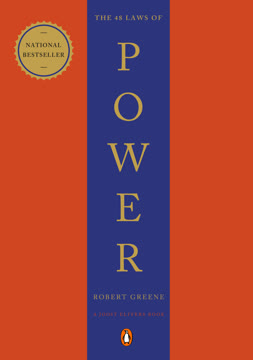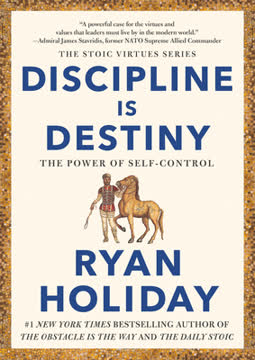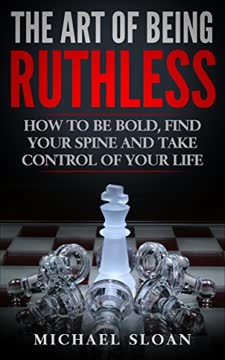Key Takeaways
1. Ruthlessness is about self-control and freedom, not cruelty.
Rather being ruthless is all about learning how to get what you actually want out of life and preventing other people from controlling you.
Define true ruthlessness. Many perceive ruthlessness as being evil, hurting people, or crushing others. However, this book redefines it as a mindset focused on self-mastery and liberation. It's about taking charge of your own life, making your own decisions, and ensuring that external forces—be it your boss, friends, or societal expectations—do not dictate your path. This isn't about corruption or shortcuts, but about cultivating a mindset that allows you to move freely, unburdened by guilt, shame, or manipulation.
Control is the core. The essence of being ruthless lies in understanding and reclaiming control. From paychecks to guilt trips, the world constantly attempts to exert influence over you. A ruthless individual recognizes these attempts and actively works to break free, becoming their own person. This freedom means you are no longer bound by others' methods of control, allowing you to pursue your desires without needing external permission or validation.
Live on your terms. Being ruthless means living life on your own terms, free from the fear of punishment or the need for approval. It's about prioritizing your authentic desires and goals, even if they diverge from societal norms. This self-directed approach allows for a moral life, as true goodness stems from choice, not from compliant obedience driven by fear.
2. Break free from the "compliance culture" and its fatal assumptions.
This creates a mentality within most people, a mentality of compliance.
Unmasking compliance. From childhood, we are conditioned to obey authority through systems of punishment and shame, fostering a "mentality of compliance." This ingrained obedience often extends into adulthood, making us agreeable to demands from bosses, partners, and society, even when it goes against our true desires. This compliance is a combination of a broken spirit, a weak will, and a deep-seated fear of consequences.
Challenging false beliefs. The book identifies four "fatal assumptions" that perpetuate this compliant mindset:
- "I Have to Obey Authority": False. You are the ultimate authority in your life; your presence is a choice.
- "If I Don’t Do as They Say Bad Things Will Happen": False. The worst outcome is losing your freedom and becoming dependent.
- "I don’t want to hurt feelings": False. You fear the emotional pain of causing others discomfort, not genuinely hurting them.
- "I’m Just a Nice Guy!": False. This is a justification for weakness and a victim mentality, blaming others for personal failures.
Reclaiming autonomy. To become ruthless, you must question and challenge these deeply held assumptions. Recognize that your fear of punishment, conflict, or disapproval is a learned response, not an inherent truth. By dismantling these mental chains, you begin to reclaim your autonomy and assert your true self, paving the way for genuine strength and confidence.
3. Be brutally honest and ruthless with yourself to foster growth.
If you want to be free from your own poor decisions, if you want be free from the things that are holding you back, then you’re going to have to acknowledge that you have been part of the problem!
Embrace introspection. The journey to ruthlessness begins with a profound, often uncomfortable, self-assessment. Modern society often discourages introspection, leading us to blame external factors for our problems. However, true change is impossible until you ruthlessly examine your own flaws, actions, and choices, accepting your role in your current circumstances. This brutal honesty, though painful, is the foundation for genuine personal growth.
Own your mistakes. Like the man who repeatedly fell into the same hole but blamed everything but his own path, we often deny responsibility for our failures. The ruthless individual understands that mistakes are not meant for punishment but for learning. By accepting fault, you gain the power to correct your course and avoid repeating past errors. This willingness to learn from failure, rather than hide it, is crucial for continuous improvement and becoming stronger.
Ask the hard questions. To facilitate this self-ruthlessness, ask yourself critical questions:
- "Is it my fault?": Take responsibility for your unhappiness, even if it stings.
- "How did I get here?": Understand the root causes of your behaviors and struggles.
- "What do I want to be?": Make a conscious, disciplined decision to become the strong, confident person you desire, embracing the discomfort of change.
4. Cut the ties of comfort, guilt, money, time, and pride to gain true freedom.
If you want to be free, if you don’t want to be beholden to anyone, then you are going to have to focus on learning how to cut those ties.
Identify your masters. To achieve true freedom, you must identify and sever the invisible ties that bind you. These are the controlling factors that keep you compliant and prevent you from living life on your own terms. The ruthless individual systematically dismantles these influences, understanding that they are often disguised as necessities or virtues.
Five controlling factors:
- Comfort: Our desire for ease makes us susceptible to corporate manipulation (debt, luxury goods). Reject comfort; embrace discomfort as a path to strength (e.g., cold showers, exercise, frugality).
- Guilt: Others use guilt as a weapon to manipulate you into unwanted actions. Don't take on others' responsibilities or allow misplaced guilt to dictate your choices.
- Money: Debt makes you a slave to lenders and employers. Master your finances, make money work for you, and reduce dependence on a paycheck to gain leverage.
- Time: Your most precious resource is often squandered or taken by others' demands. Learn to say "no" and set firm boundaries to protect your schedule and priorities.
- Pride (Vanity): Seeking external approval or validation makes you a "servant's pride," controlled by others' opinions. Find internal self-worth through practices like meditation and gratitude, freeing yourself from the need to please the crowd.
The path to liberation. Cutting these ties is not easy; it requires brutal honesty and a willingness to make difficult choices. However, the freedom gained from shedding these controls is invaluable, allowing you to live authentically and pursue your goals without external interference.
5. Embrace pragmatism: focus on what's possible and what's best for you.
The pragmatist is capable of creating a better reality for himself because he is focused more on what is possible as opposed to what should be.
Reality over idealism. Pragmatism is a ruthless, realistic mindset that prioritizes what is possible over what should be. Unlike idealists who are constantly disappointed by reality failing to meet their lofty expectations, pragmatists focus on achievable outcomes. This approach allows for flexibility and adaptation, crucial for navigating a constantly changing world and achieving your goals.
Key pragmatic thinking tips:
- Think about what’s possible: Don't cling to failing ideas. Ruthlessly eliminate what doesn't work and focus on effective solutions. A pragmatist moves on from sinking ships, prioritizing what yields results.
- Skepticism: Approach promises and claims with a critical lens. Demand proof rather than blindly believing what sounds good. This protects you from manipulation and false hopes, ensuring decisions are based on reality.
- Ask What Is Best?: Always evaluate situations for the best possible outcome for you. This isn't about being selfish in a negative sense, but about making choices that serve your highest interests. Like the ethical dilemma of the train tracks, the pragmatist chooses the action that yields the greatest good, often for themselves first.
Action-oriented approach. Pragmatism is inherently action-oriented. It's about making decisions based on tangible reality, not emotions or fantasies. By adopting this mindset, you become more effective, consistently getting things done and achieving satisfaction, even if the choices aren't always "ideal."
6. Cultivate authentic boldness through freedom, relaxation, and self-esteem.
Confidence is a combination of freedom, relaxation and self-esteem.
Beyond mere posing. True boldness isn't about outward bravado or pretending to be tough; it's an authentic expression of inner confidence. Posers merely mimic confidence, but a truly bold individual is free from the fear of punishment and external control. This genuine confidence is built upon three interconnected pillars, each requiring deliberate cultivation.
The three pillars of confidence:
- Freedom: You cannot be confident if you are constantly afraid of punishment or beholden to others. Establish strong boundaries by learning to say "no," and work towards financial independence. When you know you can walk away from a controlling situation, your confidence naturally soars.
- Relaxation: A confident person is calm, not anxious or agitated. This state comes from not worrying excessively about the future, but rather being present and grateful for the now. A relaxed mind thinks clearly and communicates effectively, projecting an aura of control.
- Self-esteem: This is about realizing your intrinsic value, independent of external validation. Stop seeking approval from others (peers, bosses, partners) through superficial means like materialism or overwork. Practices like meditation and gratitude help you find satisfaction within yourself, making you resilient to external criticism and secure in who you are.
Confidence in action. Boldness is confidence applied. By diligently working on these three areas, you build an unshakeable inner foundation. This allows you to act decisively, speak your mind, and pursue your desires without being undermined by fear or the need for external approval.
7. Act with courage, urgency, and opportunism to achieve your desires.
Fortune favors the bold, as the saying goes, and if you delay too much, you could miss out on something very valuable.
Boldness in motion. Once confidence is cultivated, boldness becomes its natural expression. It's about taking decisive action, even when it feels uncomfortable or risky. The ruthless individual doesn't just feel confident; they act boldly, pushing past hesitation to seize opportunities and achieve their goals.
Three drivers of boldness:
- Urgency: The bold individual understands the preciousness of time. They don't procrastinate or wait for perfect conditions; they act quickly and effectively. This sense of urgency propels them forward, ensuring tasks are completed and opportunities are not missed.
- Courage: This is the ability to move forward in spite of fear, not in its absence.
- Do the Hard Things: Embrace discomfort and difficulty as opportunities for growth. Taking the stairs, having tough conversations, or pushing physical limits builds resilience.
- Ignore the Feelings: Acknowledge fear, but refuse to let it dictate your actions. By acting despite emotional discomfort, you weaken fear's grip and strengthen your resolve.
- Opportunism: The ruthless individual has a keen eye for opportunities and acts swiftly to capitalize on them. They prefer to fail spectacularly by taking a chance than to let a valuable opportunity pass them by due to hesitation or overthinking.
Unleash your potential. By integrating urgency, courage, and opportunism into your actions, you transform confidence into tangible results. This proactive approach allows you to navigate challenges, seize advantages, and ultimately achieve the significant things you desire in life.
8. Recognize and embrace your inherent authority in life.
You are already your own boss! You are already the one who’s in charge. You just haven’t accepted that role yet.
The ultimate authority. Many people dream of being their own boss, yet fail to realize they already are. We voluntarily place ourselves under various authorities (parents, teachers, employers), but the ultimate authority to do so rests with us. The ruthless individual understands that true authority is inherent, not granted by others. It stems from an unalienable right to self-governance, a fundamental truth often obscured by a compliant society.
Trade safety for freedom. Accepting your role as an authority figure means embracing risk. The "safe" path of compliance offers an illusion of security, but at the cost of freedom. Leaders, like company owners, take risks and make hard decisions, while compliant individuals risk little. To be truly in charge of your life, you must be willing to trade perceived safety for the inherent struggle and immense rewards of freedom.
How to embody authority:
- Be Tough: Be firm, unapologetic, and unwavering in your principles. Define your non-negotiables and stick to them, even in conflict.
- Be Active: Reject passivity. Don't wait for problems to disappear or for others to act. Take initiative and get things done yourself.
- Be Comfortable with Confrontation: Authority often requires confronting uncomfortable truths or challenging others. See confrontation as a positive tool for growth and problem-solving, not as a negative act.
- Develop Thick Skin: Don't be easily offended. Others' words or criticisms should not control your emotions or actions. An authority figure can take a punch and remain objective, focusing on the goal rather than personal attacks.
9. Master healthy confrontation to get what you want.
Confrontation is at its core making the decision to tell someone something that they won’t like.
Confrontation redefined. Confrontation is simply expressing something that another person may not like, whether it's a disagreement, a boundary, or a demand. It's not about anger, yelling, or physical violence. The key distinction is intention: healthy confrontation aims to get your way or express desires, while unhealthy confrontation seeks to cause harm or chaos. Avoiding confrontation prevents personal growth and the resolution of problems.
Truths about confrontation:
- Confrontation is healthy: It allows for self-expression and, when done without violence (tone, words), can improve relationships and solve disputes. Healthy confrontation is purposeful, respectful, non-emotional, clear, and non-personal. Unhealthy confrontation is destructive, disrespectful, emotional, and personal.
- Confrontation makes you stronger: Each engagement builds experience, reduces nervousness, and strengthens your assertiveness. Like lifting weights, consistent practice makes you more capable of handling conflict.
Elements of effective confrontation:
- Assertiveness: Forcefully and clearly state your opinions and desires without backing down. This is about being heard, not aggressive.
- Readiness: Actively seek opportunities to engage in confrontation, viewing them as chances to refine your skills rather than obstacles to avoid.
- Playfulness: Approach confrontations with a sense of sportsmanship or excitement, rather than fear. This reframes the experience and reduces stress.
- Honesty: Be truthful about your position and desires. Hiding your feelings or lying prevents you from getting what you truly want.
- Goal-oriented: Always know your objective before entering a confrontation. This "anchor" keeps you focused and prevents emotional derailment.
10. Employ strategic tactics to win any confrontation.
When you lose your cool in an argument, you essentially lose the argument.
Tactical advantage. Winning a confrontation isn't about being the loudest or most aggressive; it's about strategic execution. By employing specific tactics, you can maintain control, steer the conversation, and increase your chances of achieving your desired outcome. These tactics are designed to navigate the emotional and logical complexities of disagreement effectively.
Winning tactics:
- Stay cool: Emotional outbursts lead to loss of control. Focus on your goal, not on anger or frustration. Deep breathing and remembering your objective can help you remain calm.
- Never defend: Avoid getting sidetracked by accusations or unrelated issues. Politely state that the topic is not the current point of discussion, keeping the focus on your agenda.
- Repeat yourself: Consistently reiterate your main point or goal. This keeps the conversation on track and ensures your intentions are clear, reducing defensiveness from the other party.
- Never get personal: Avoid name-calling or character attacks. Focus on behaviors and issues, not the individual. Use non-judgmental language (e.g., "how their behavior affects you") or the "sandwich technique" for criticism to disarm defensiveness.
- Make them feel like you are on their side: Frame your arguments in terms of their benefit or shared goals. Even if your intentions are self-serving, perceived empathy can lead to more constructive dialogue.
- Do your homework: Gather all relevant information and identify potential vulnerabilities. Hold onto crucial facts until they can be used most advantageously, like a politician saving "dirt" for maximum impact.
- Have perspective: Understand your opponent's viewpoint, values, and emotional temperament. This empathy allows you to tailor your communication for maximum effectiveness, as "perception is reality" in a confrontation.
- Always go high: In negotiations, ask for more than you truly want. This creates room for them to "counter" with your actual desired outcome, making them feel like they've secured a good deal.
Last updated:
Review Summary
The Art Of Being Ruthless receives mostly positive reviews, with readers praising its practical advice on assertiveness and self-improvement. Many find it empowering, helping them prioritize their own needs and goals. Reviewers appreciate the book's straightforward approach and easy-to-apply lessons. Some critics, however, find it repetitive or lacking depth. The book is described as concise, motivational, and helpful for building confidence and taking control of one's life. Overall, it's recommended for those seeking personal growth and a more proactive mindset.
Similar Books










Download PDF
Download EPUB
.epub digital book format is ideal for reading ebooks on phones, tablets, and e-readers.




